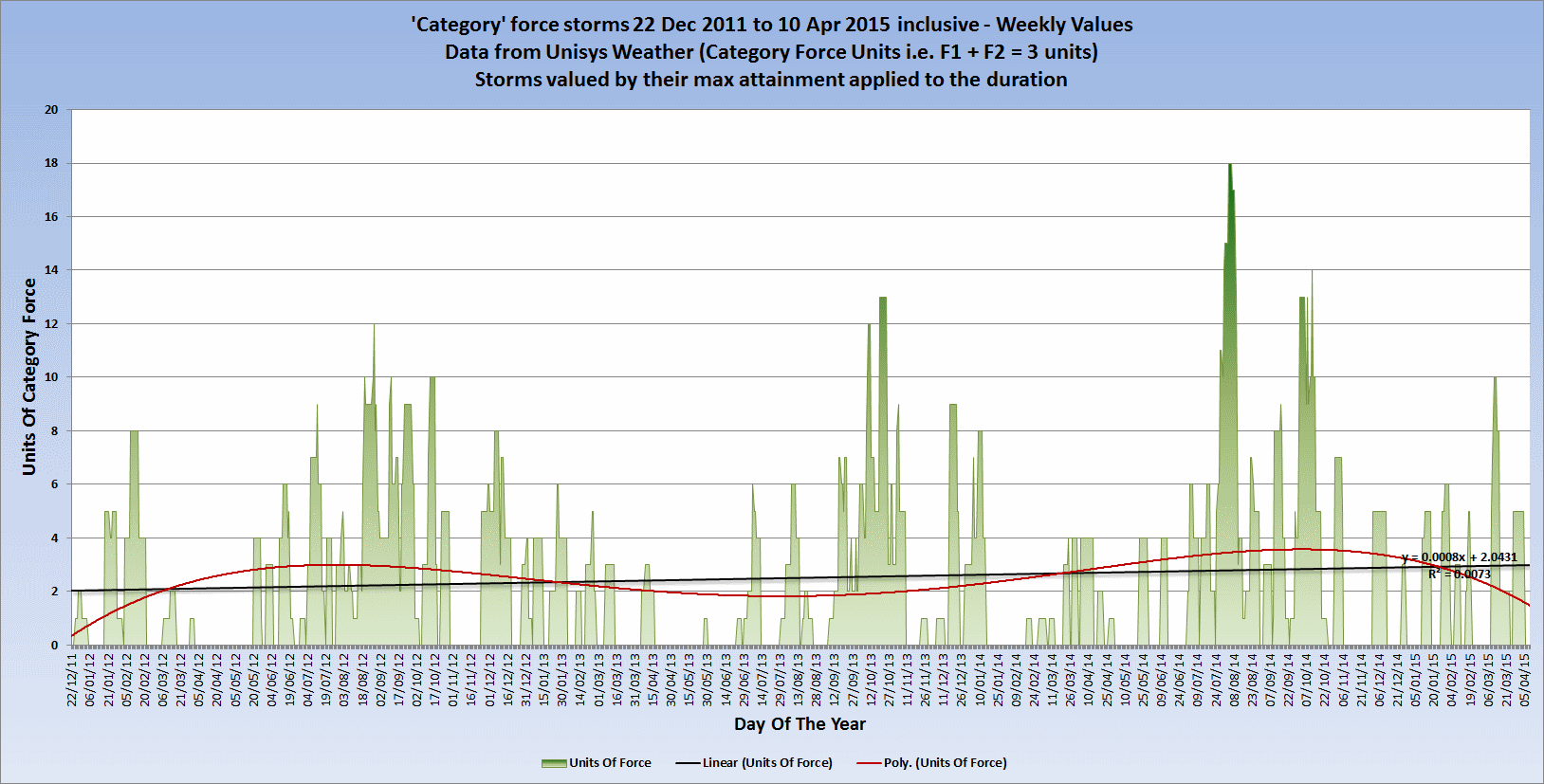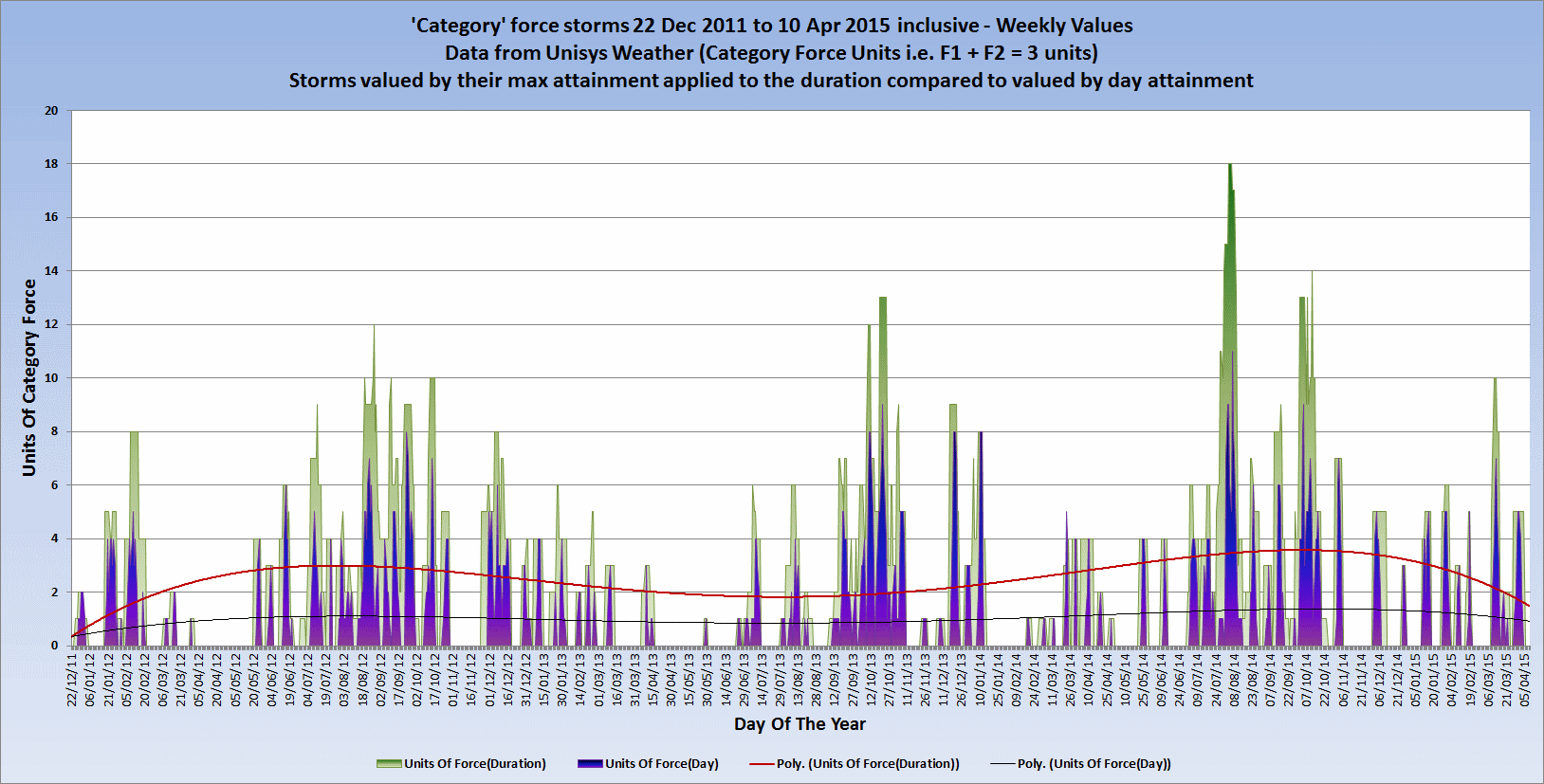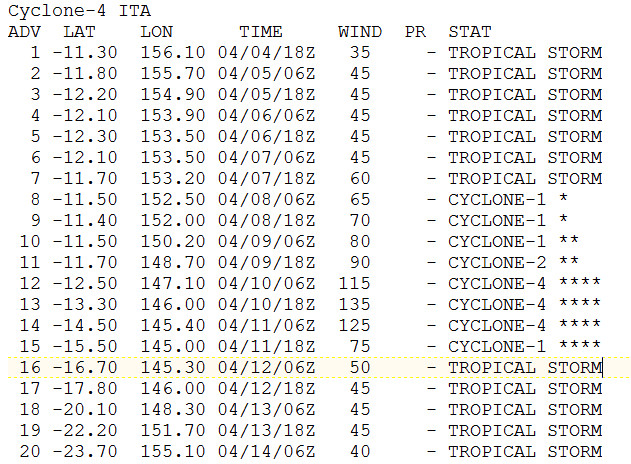It looks like you're using an Ad Blocker.
Please white-list or disable AboveTopSecret.com in your ad-blocking tool.
Thank you.
Some features of ATS will be disabled while you continue to use an ad-blocker.
12
share:
Or are they??????
Once again we are enticed into believing so by the figures where the force of the storm is quoted for the duration of the storm. The chart below shows the storms from December 2011 to now charted by quoted duration.

Click the image to enlarge
Now compare the duration to the actual category force values by day (and see the explanation below the chart)

Click the image to enlarge
The comparison chart above shows the Category force storms as they are reported for the duration of the storm as in the top chart. This generally includes the lead in period as the storm builds and the lead out as it decreases to tropical storm or lower force, i.e. under category force.
The day element of the comparison only shows where a storm is reported as being category force. For any day that the storm is being reported as category force the higher of any force value is taken.
If we look at a storm such as ITA (back in April 2014 - because I happen to have that comparison) we can see that the storm duration was reported as from 04 April to 14 April.

Up to 0600 Zulu (GMT/UTC) on 08 April the storm was a Tropical storm. During the 8th it was Cyclone 1 so for the 8th it is counted as one unit of force. Shown below as *
On the 9th it was one, rising to Cyclone 2 by the evening so it is counted as 2 ** for the day. On the 10th it was 4 **** and on the 11th it was Cyclone 4 dropping to Cyclone 1 so the whole day is counted as Cyclone 4 ****. It was back to a tropical storm again on the 12th.
The comparison gives one a better idea than using just the duration since ITA was 11 days duration, but was only Category 4 on 2 of those days.
Looking again at the Dec 2011 to Apr 2015 comparison you can see that whilst the reported durations have increased the actual days at category force have not, or have only so slightly as to be almost imperceptible.
In my opinion there has been no increase over the past 3+ years in the category force storms. The quoted ITA example is but one where that which is reported belies the facts.
I am not saying that there is a deliberate attempt to mislead. Scientists would not do that would they?
Once again we are enticed into believing so by the figures where the force of the storm is quoted for the duration of the storm. The chart below shows the storms from December 2011 to now charted by quoted duration.

Click the image to enlarge
Now compare the duration to the actual category force values by day (and see the explanation below the chart)

Click the image to enlarge
The comparison chart above shows the Category force storms as they are reported for the duration of the storm as in the top chart. This generally includes the lead in period as the storm builds and the lead out as it decreases to tropical storm or lower force, i.e. under category force.
The day element of the comparison only shows where a storm is reported as being category force. For any day that the storm is being reported as category force the higher of any force value is taken.
If we look at a storm such as ITA (back in April 2014 - because I happen to have that comparison) we can see that the storm duration was reported as from 04 April to 14 April.

Up to 0600 Zulu (GMT/UTC) on 08 April the storm was a Tropical storm. During the 8th it was Cyclone 1 so for the 8th it is counted as one unit of force. Shown below as *
On the 9th it was one, rising to Cyclone 2 by the evening so it is counted as 2 ** for the day. On the 10th it was 4 **** and on the 11th it was Cyclone 4 dropping to Cyclone 1 so the whole day is counted as Cyclone 4 ****. It was back to a tropical storm again on the 12th.
The comparison gives one a better idea than using just the duration since ITA was 11 days duration, but was only Category 4 on 2 of those days.
Looking again at the Dec 2011 to Apr 2015 comparison you can see that whilst the reported durations have increased the actual days at category force have not, or have only so slightly as to be almost imperceptible.
In my opinion there has been no increase over the past 3+ years in the category force storms. The quoted ITA example is but one where that which is reported belies the facts.
I am not saying that there is a deliberate attempt to mislead. Scientists would not do that would they?
Depends on how they arrive at a measure of force. When the cyclone you charted reduces to a category 1 at the end it still gets "four stars". What
goes into that determination?
Is there a link to their formula for that?
Is there a link to their formula for that?
a reply to: intrptr
It got four stars (an illustrative value representing force 4) because ON THE DAY, in this case the 11th April, the maximum logged category force was 4 at 0600 Zulu thus I count it as force 4 for the whole day regardless of whether it drops lower than that during the duration of that day.
By the same method on the 9th April the storm was recorded as Force 1 @ 0600Z but at 1800Z it was force 2 (2 stars) so I count it as Force 2 for the whole of that day.
It got four stars (an illustrative value representing force 4) because ON THE DAY, in this case the 11th April, the maximum logged category force was 4 at 0600 Zulu thus I count it as force 4 for the whole day regardless of whether it drops lower than that during the duration of that day.
By the same method on the 9th April the storm was recorded as Force 1 @ 0600Z but at 1800Z it was force 2 (2 stars) so I count it as Force 2 for the whole of that day.
a reply to: PuterMan
So then these are your charts?
Isn't that sort of cheating though? If the storm is a category 1 its a category 1, regardless of what day. You gave it extra stars…
(insert loud buzzer sound)
So then these are your charts?
It got four stars (an illustrative value representing force 4) because ON THE DAY, in this case the 11th April, the maximum logged category force was 4 at 0600 Zulu thus I count it as force 4 for the whole day regardless of whether it drops lower than that during the duration of that day.
Isn't that sort of cheating though? If the storm is a category 1 its a category 1, regardless of what day. You gave it extra stars…
(insert loud buzzer sound)
a reply to: intrptr
The point is this: It is not cheating at all because during the day it was Force 4. Remember that the 'official' version is that it is Force 4 even when it is just a tropical storm.
If I was calling it force 1 when it was force 4 that would be cheating, but I am not. I am saying that because it was force 4 during some part of the day it is called force 4 for that day.
If the day was split into quarters then the storm would have been force 4 in the first quarter (or half) and then force 1 for the remainder. That would in fact mean that the incidence of category force would be even smaller than I am currently allowing for.
ETA: I should have given you the links for the data from which I created the charts
The home page, West pacific as an example on which is MAYSAK tracking data which are the types of figure I use above. On this one you can see that although called a Super Typhoon 5 for the period 27 MAR-05 APR 2015 it was on such on 2 days:
18 10.00 141.30 03/31/06Z 140 - SUPER TYPHOON-5
19 10.20 139.90 03/31/12Z 140 - SUPER TYPHOON-5
20 10.30 138.70 03/31/18Z 140 - SUPER TYPHOON-5
21 10.70 137.70 04/01/00Z 140 - SUPER TYPHOON-5
The point is this: It is not cheating at all because during the day it was Force 4. Remember that the 'official' version is that it is Force 4 even when it is just a tropical storm.
If I was calling it force 1 when it was force 4 that would be cheating, but I am not. I am saying that because it was force 4 during some part of the day it is called force 4 for that day.
If the day was split into quarters then the storm would have been force 4 in the first quarter (or half) and then force 1 for the remainder. That would in fact mean that the incidence of category force would be even smaller than I am currently allowing for.
ETA: I should have given you the links for the data from which I created the charts
The home page, West pacific as an example on which is MAYSAK tracking data which are the types of figure I use above. On this one you can see that although called a Super Typhoon 5 for the period 27 MAR-05 APR 2015 it was on such on 2 days:
18 10.00 141.30 03/31/06Z 140 - SUPER TYPHOON-5
19 10.20 139.90 03/31/12Z 140 - SUPER TYPHOON-5
20 10.30 138.70 03/31/18Z 140 - SUPER TYPHOON-5
21 10.70 137.70 04/01/00Z 140 - SUPER TYPHOON-5
edit on 12/4/2015 by PuterMan because: (no reason given)
a reply to: PuterMan
As always PM, nice job on the data collecting.
So if I'm reading this correctly, what you're saying is: "Hyperbole is as hyperbole does." ?
I equate this sort of thing as the same type of hyperbolic soapbox claims such as this new fad of now giving common winter storms names like "Diana" and "Andy"... It serves of purpose giving the illusion that these common annual storms are suddenly far more wicked and terrifying than they've ever been before in human history.

As always PM, nice job on the data collecting.
So if I'm reading this correctly, what you're saying is: "Hyperbole is as hyperbole does." ?
I equate this sort of thing as the same type of hyperbolic soapbox claims such as this new fad of now giving common winter storms names like "Diana" and "Andy"... It serves of purpose giving the illusion that these common annual storms are suddenly far more wicked and terrifying than they've ever been before in human history.

new topics
-
University of Texas Instantly Shuts Down Anti Israel Protests
Education and Media: 18 minutes ago -
Any one suspicious of fever promotions events, major investor Goldman Sachs card only.
The Gray Area: 2 hours ago -
God's Righteousness is Greater than Our Wrath
Religion, Faith, And Theology: 6 hours ago -
Electrical tricks for saving money
Education and Media: 10 hours ago -
VP's Secret Service agent brawls with other agents at Andrews
Mainstream News: 11 hours ago
top topics
-
VP's Secret Service agent brawls with other agents at Andrews
Mainstream News: 11 hours ago, 9 flags -
Cats Used as Live Bait to Train Ferocious Pitbulls in Illegal NYC Dogfighting
Social Issues and Civil Unrest: 15 hours ago, 8 flags -
Nearly 70% Of Americans Want Talks To End War In Ukraine
Political Issues: 12 hours ago, 4 flags -
Electrical tricks for saving money
Education and Media: 10 hours ago, 4 flags -
Sunak spinning the sickness figures
Other Current Events: 12 hours ago, 3 flags -
Late Night with the Devil - a really good unusual modern horror film.
Movies: 14 hours ago, 2 flags -
Any one suspicious of fever promotions events, major investor Goldman Sachs card only.
The Gray Area: 2 hours ago, 2 flags -
The Good News According to Jesus - Episode 1
Religion, Faith, And Theology: 17 hours ago, 1 flags -
God's Righteousness is Greater than Our Wrath
Religion, Faith, And Theology: 6 hours ago, 0 flags -
University of Texas Instantly Shuts Down Anti Israel Protests
Education and Media: 18 minutes ago, 0 flags
active topics
-
Nearly 70% Of Americans Want Talks To End War In Ukraine
Political Issues • 25 • : Consvoli -
God's Righteousness is Greater than Our Wrath
Religion, Faith, And Theology • 24 • : randomuser2034 -
15 Unhealthiest Sodas On The Market
Health & Wellness • 43 • : JPRCrastney -
University of Texas Instantly Shuts Down Anti Israel Protests
Education and Media • 0 • : FlyersFan -
Sunak spinning the sickness figures
Other Current Events • 9 • : Ohanka -
The Acronym Game .. Pt.3
General Chit Chat • 7748 • : bally001 -
HORRIBLE !! Russian Soldier Drinking Own Urine To Survive In Battle
World War Three • 37 • : FlyersFan -
Any one suspicious of fever promotions events, major investor Goldman Sachs card only.
The Gray Area • 3 • : seekshelter -
-@TH3WH17ERABB17- -Q- ---TIME TO SHOW THE WORLD--- -Part- --44--
Dissecting Disinformation • 662 • : F2d5thCavv2 -
SETI chief says US has no evidence for alien technology. 'And we never have'
Aliens and UFOs • 61 • : andy06shake
12
